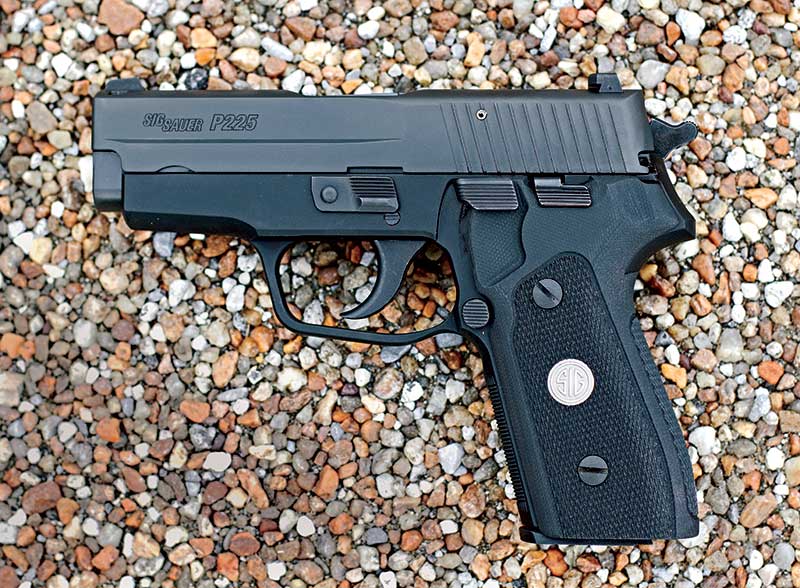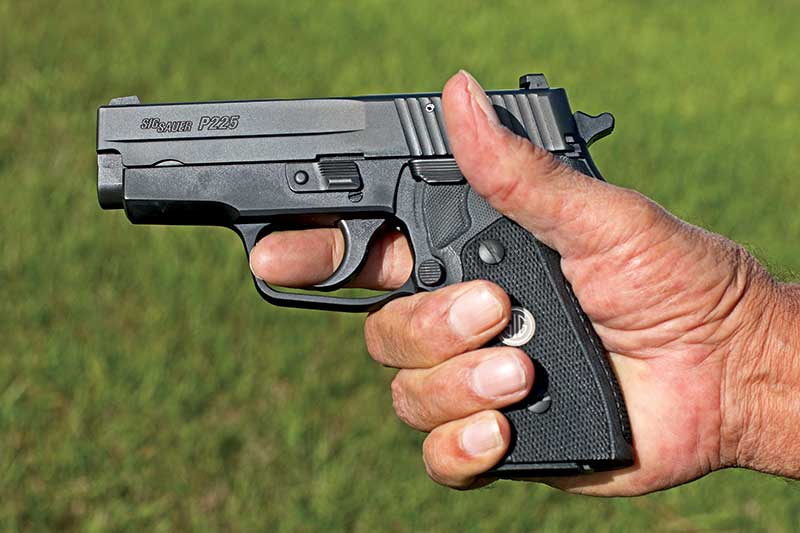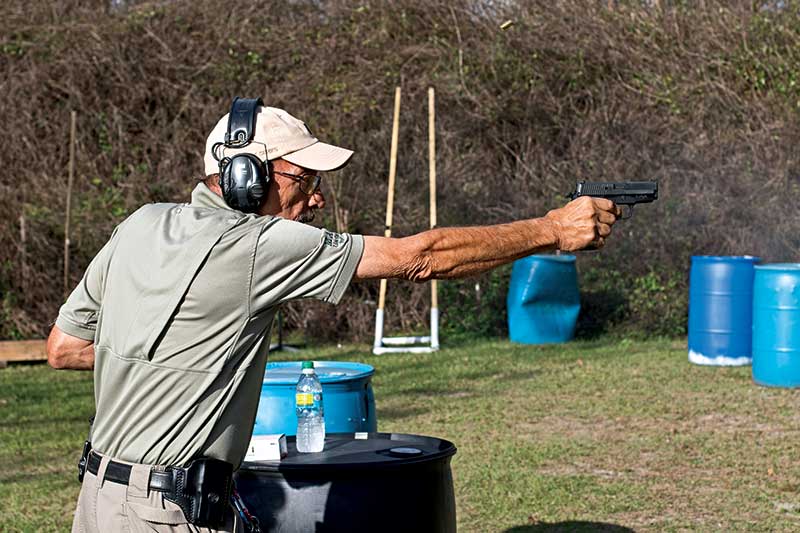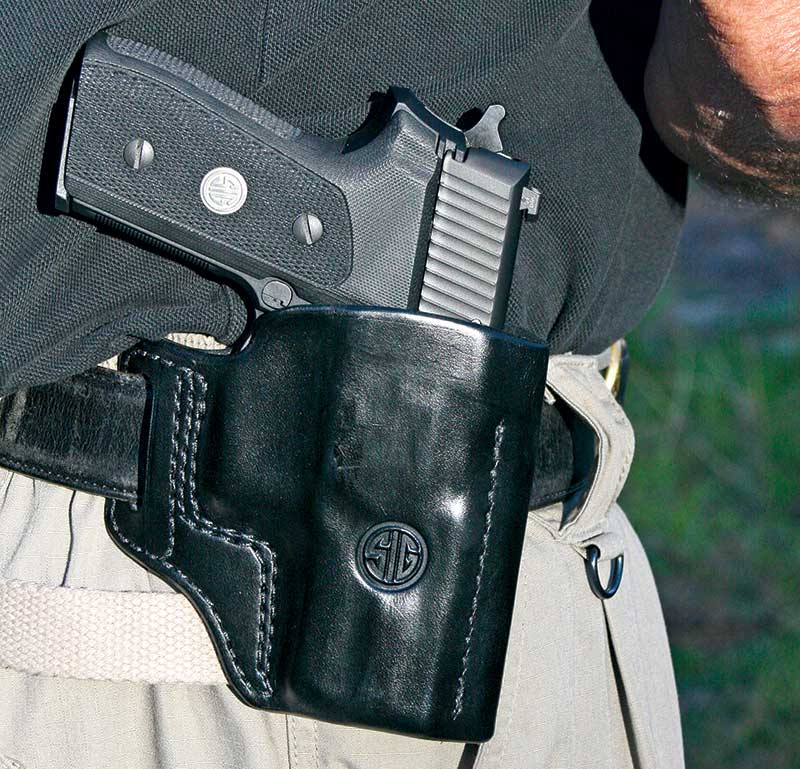The P225-A1
Timeless SIG Look Updates a Classic Model
In recent years, SIG has produced an almost dizzying array of variations on their long-established P2XX series. The latest is an update of a pistol much missed by a lot of SIG fans, the single-stack 9mm P225. “P225” is what’s stamped on the slide, but the design is changed enough from the original it’s called “P225-A1” in SIG’s literature.
A Brief History
SIG SAUER’s P225 9mm was their second double action auto, a compact version of their original P220 and the first SIG to have a side-button magazine release. It was soon eclipsed by the similar sized, but thicker-gripped P228 with higher capacity, and was replaced in the SIG catalog by the introduction of the slim single-stack P239 circa 1996. The P239 was — brilliantly, I think — marketed by SIG as a “personal size” pistol, and remains in their catalog today. In late 2015, it was resurrected as the P225-A1, tested here.
Why not simply bring back the original P225, known in Europe as the P6? Tim Butler, whose title at SIG is Product Manager, Pistols, told Handgunner, “The original P225 was designed for round nose full metal jacket ammo, and some specimens had feeding problems with some hollow points. We didn’t want to do a sheet metal slide; we learned over the years we could make a better gun.” The magazine is so close to a P239 it will work in that gun, though it doesn’t go the other way because the P239 mags are a bit short for the P225-A1. And there’s no interchangeability at all with the original P225.
In The Hand
What made the original P225 “a gun of the cognoscenti” was its slim grip and short trigger reach. Several members of the American Handgunner team can tell you why. Decades ago, I was hired as an expert witness for a female FBI agent who was fired for failure to qualify with the then-issue weapon, the big Smith & Wesson Model 1076 10mm.
She was a petite female with small hands. I took her to the range and ran her over what was then the FBI qualification course, at a time when the Bureau allowed compact single-stack 9mm S&Ws (like director Louis Freeh carried) and SIG’s. With a SIG P225 and a Smith 3913, she passed easily. At the eleventh hour, familiar with these test results, the Department of Justice settled the case to the young former agent’s satisfaction.
Our own editor, Roy Huntington, carried a P225 for years on San Diego PD, because being able to get “more hand around the gun,” he shot the 8+1 P225 faster and straighter than he did the 15+1 P226 or other higher-cap 9mms. His wife Suzi found the same to be true, and carried a P225 to the end of her distinguished city cop career, as well.
“Trigger reach,” the dimension from the center of the backstrap of the grip to the center of the trigger, was short enough on the original P225 for those with short fingers to do their best shooting, and amenable to those of us with average or larger finger length who center the first joint of the index finger on the trigger to get the most leverage. I didn’t have an original P225 on hand for comparison, but if memory serves, the P225-A1 has only slightly longer trigger reach than the original, and a bit less than the P239. Our test team ranged from 5′ female to 6′ males, and without exception, their judgment was, “This gun fits our hands very well.”
Trigger Weights
Double action first shot trigger pull weight is spec’d by the factory at 10 pounds double action, four pounds single action. At this end, we measured it twice, from the toe (bottom edge) of the trigger and again from the center. Why? Because a pivoting trigger is a lever, and the farther out you get from the fulcrum, the less effort you need. At the toe, which was sharp-edged enough you really wouldn’t want to work it from there, pull weight on a digital Lyman scale from Brownell’s ran an average 10 and a quarter pounds.
However, most human fingers pull from the center of the trigger, and readings there ranged from 11 and a half pounds to, repeatedly, “OVER” since the Lyman device stops at 12 pounds. Therefore, I’d have to say the real world DA pull was “twelve-ish.” That said, it was smooth and predictable.
Our pistol was TDA (Traditional Double Action) format in which every shot after the first is automatically cocked to single action until the shooter activates the de-cocking lever. Measured from the toe of the trigger, the single action pull on P225-A1 serial number 26A001582 was 4.85 pounds average. From the center, it averaged 5.65 pounds. These weights are well within what the police establishment and the firearms industry alike have determined to be “safe” trigger pulls for handguns of this type.
This pistol comes with something that has received virtually unanimous acclaim from SIG SAUER fans, the Short Reset trigger. All I can say is, I join in the acclaim.
Off The Bench
Hand-held on a Matrix rest set upon a concrete bench at 25 yards, the P225-A1 was accuracy-tested with examples of the three most popular bullet weights in its 9mm. Because I had seen occasional earlier P225’s that “clicked” instead of “banged” on 9mm loads in the 1,300+ velocity range because the slide was running so fast it closed before the P225’s magazine could get a round up into it, I chose Federal +P+ 9BPLE 115-gr. hollow point rated for 1,300 fps. It ran fine in the test P225-A1, and put five shots in 2.90″, measuring the farthest-flung bullet holes center to center to the nearest 0.05″. Four of them were in 1.60″ and the best three, in 1.30″.
This group was a good example of why I always measure the best three. Over the years, I learned this would closely approximate what the same gun and load would do for all five from a machine rest, because it compensates for unnoticed shooter error.
For a 124-gr. load it just seemed right to use SIG’s own V-Crown JHP. The whole quintet of bullets went into 1.70″, with four in 1.30″ and the best three in a mere 0.85″. Remington’s UMC 147-gr. subsonic full metal jacket training load, so accurate I’ve seen it win pistol matches, did 2.30″ for all five shots, with four in 1″ exactly, and the best three in a cloverleaf so tight it was hard to measure center to center, but looked to be about 0.40″. For a compact auto pistol, in a world where it’s widely said four inches is acceptable grouping for a full size service pistol — that’s impressive.
On The Range
When a writer tests a deer rifle, he tries to go hunting with it. In the same vein, when I test a defensive pistol, I like to do some defensive-type shooting with it. Trolling for muggers is not a good plan, so I try to shoot a match or at least a police-type qualification with the test sample. The P225-A1 comes with only two magazines, so most “combat matches” were out. Instead, I took it to a range day to join some fellow competitors in practicing Bill Wilson’s “5X5 Drill,” which only requires one timed reload.
It’s scored on an electronic gunshot timer, with half a second added to your time for every point down from perfect, and all from 10 yards. On the initial run, I rushed the first couple of shots and got a “down 3” and a “down 1,” with another “down 1” at the end of things, and finished with an “expert” qualification in the low 20-second range.
I tried it again, slowing down, and shot it clean with no points down, but “slowing” was the operative term there, and I didn’t get under 20 seconds to get up from “expert” to “master.” Still, for a first outing with a new-to-me, out of the box pistol, I was happy with the outcome.
More telling was the experience of my friend Allen Davis, a retired career cop and Five-Gun Expert in IDPA. His score on the Wilson drill with the SIG after firing only a few magazines, was within a very few seconds of what he shot with his much more familiar competition pistol.
And, more important, throughout the entire several hundred rounds of our test, the P225-A1 experienced no mechanical malfunctions. Not surprising from a SIG.
On The Hip
SIG provided the pistol with a “SIG”-branded Mitch Rosen zero-cant hip holster for a SIG P250 Compact, having determined this size would fit the P225-A1. It did. This is good news: too often, we can be “the first on our block” to get a new handgun, only to find out no one is making holsters for it yet. I wore it for a weekend and found it comfortable and fast, requiring no break-in. The spare magazine rode in a generic leather pouch which, designed originally for a 1911 .45 magazine, was just a tad loose. I used the same rig for that challenging Wilson 5X5 drill.
Perks n’ Quirks
There’s little I can complain about insofar as this pistol’s performance. It shot a tad left for most of us with most loads, but it still cleaned a Bianchi Cup table of six Action Target steel 8″ plates with six shots at 25 yards. One retro thing I didn’t want back was a long-standing quirk of old SIG days: grip screws shooting loose. Alas, the P225-A1 started showing this at about 200 rounds, with top left and lower right grip screws needing the kiss of the screwdriver. Other than that, testers unanimously liked the black, checkered G10 grips.
Accuracy was pleasing. The test team unanimously liked this pistol, and found it fun to shoot. Why a P225-A1 instead of a P239 doing the same thing in the same size/weight range for over $100 less? Explains Tim Butler, “The P239 was and is a fine pistol, but its sales suffered because many thought ‘it didn’t look like a SIG.’ In ‘talking to the core,’ serious SIG enthusiasts, we determined it would be important for this gun to have the more classic SIG Sauer look.”
There are intangibles here involving the individual shooter’s sense of esthetics, and the feel of each pistol in their hand. Why this “old school” pistol at MSRP $1,125 ($1,236 with night sights), instead of choosing the polymer frame P250, which also has an external hammer and holds 15 rounds of 9mm in its magazine, and has an MSRP of only $466? Your preference as to style and design, pure and simple. Choice is good.
While the gun is engineered to handle .40 S&W and .357 SIG, like the P239 before it, SIG is holding off on chambering it for those rounds pending proven demand, due to the burgeoning market lust for the 9mm right now. And, yes, down the road it’s on the list to appear in the prestigious new Legion style.










